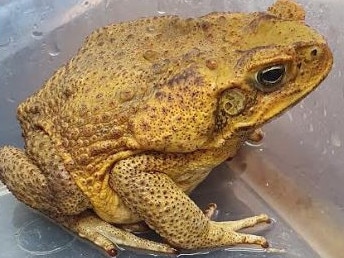Cane toad captured in Sydney: Pest found at Narraweena
Exclusive pictures show the rogue cane toad that invaded the northern beaches, as authorities scramble to ensure the male did not have a breeding partner.
Manly
Don't miss out on the headlines from Manly. Followed categories will be added to My News.
The northern beaches is on alert after a rogue cane toad was found and captured in a suburban street.
A Narraweena resident discovered the invasive pest after out walking her dog near her home in Waratah Pde on Wednesday.
Cane toads are toxic if their skin is eaten and are especially poisonous to cats and dogs and a number of native animals.
The resident managed to capture the amphibian in a clear plastic container before reporting the discovery to the NSW Department of Primary Industries (DPI).

The woman sent photographs of the toad to DPI who sent one of its expert Invasive Species Officer, Ian Turnbull to investigate the find.
Mr Turnbull piked the toad up on Thursday afternoon and with the help of an expert from Macquarie University, identified the amphibian as a mature male cane toad.
After interviewing the woman who found the toad, and her neighbours, Mr Turnbull said it was likely the animals was a “stowaway” who hitched ride south in a vehicle.
Mr Turnbull said the cane toads have established a permanent population in northern NSW after migrating south from north Queensland.

They were introduced to Queensland from South America in 1935 in an unsuccessful attempt to control cane beetles, a pest of the sugar cane industry.
“The woman was put walking her dog when it sniffed something. She went and grabbed a container and put it over the toad and slipped the lid in from underneath, like she was catching a spider,” Mr Turnbull said.
“It was important that we identified whether it was a male or female, because a pregnant female can deposit a clutch of up to 30,000 eggs at one time.
“Thankfully it was a male, but we still have to work out if it may have had a mate that it can breed with.”
Mr Turnbull said in recent years there have been eight to 10 captures of cane toads a year in the greater Sydney area.
In the past four months cane toads have turned up at Castle Cove, Eastwood, Hornsby, Caringbah, Rosehill Racecourse and Coogee, as well as Narraweena.
Northern Beaches Council said “a handful” of cane toads have previously been found in the area but “it is suspected they were transported unwittingly under cars or trailers”.

The council said the cane Toads have no natural enemies and compete for food with other carnivores and prey on small vertebrates like skinks and poison larger predators such as raptors and goannas.
“Cane Toads have a lethal toxin to many animals, threatening the survival of some of our native species.” the council website states.

IF YOU THINK YOU’VE FOUND A CANE TOAD:
(Source: NSW Department of Primary Industries)
• Put on protective clothing such as disposable gloves, a long-sleeved shirt and eye
protection;
• Take care when collecting the animal, as poison can ooze or squirt from glands on the side
of its head;
• Handle the animal with care and keep it in a well-ventilated container with a little water in a
cool location;
• Take photos of the animal (including photos of the animal’s head, body and feet), record
the location where the animal was detected and provide the information to NSW DPI using
the ‘Report a biosecurity concern’ online reporting form, or by email to invasive.species@dpi.nsw.gov.au;
• Wait until NSW DPI has positively identified the animal and provided further management
instructions.
Link to the cane toad sighting form: https://www.dpi.nsw.gov.au/biosecurity/forms/report-an-unusual-animal-sighting



